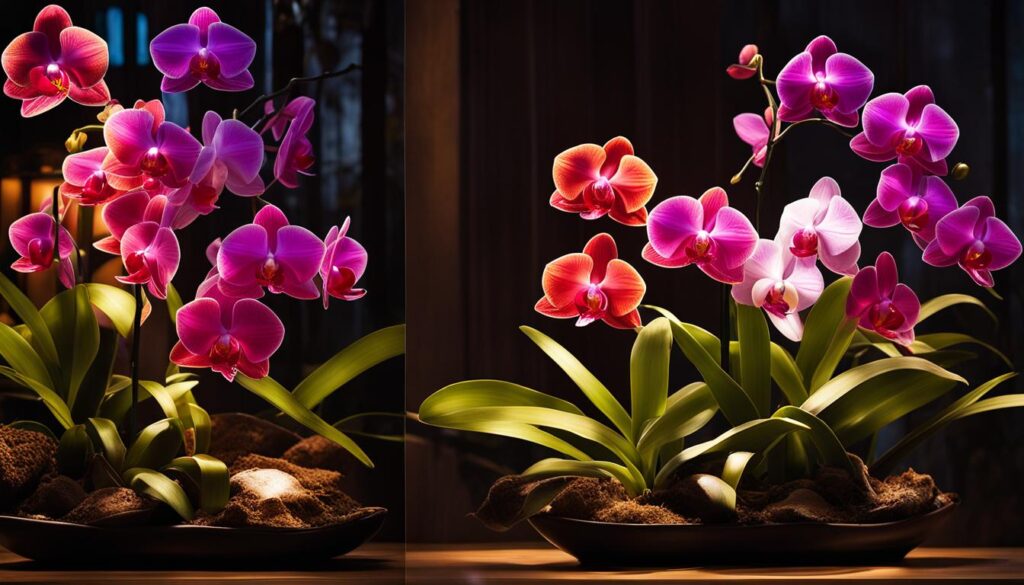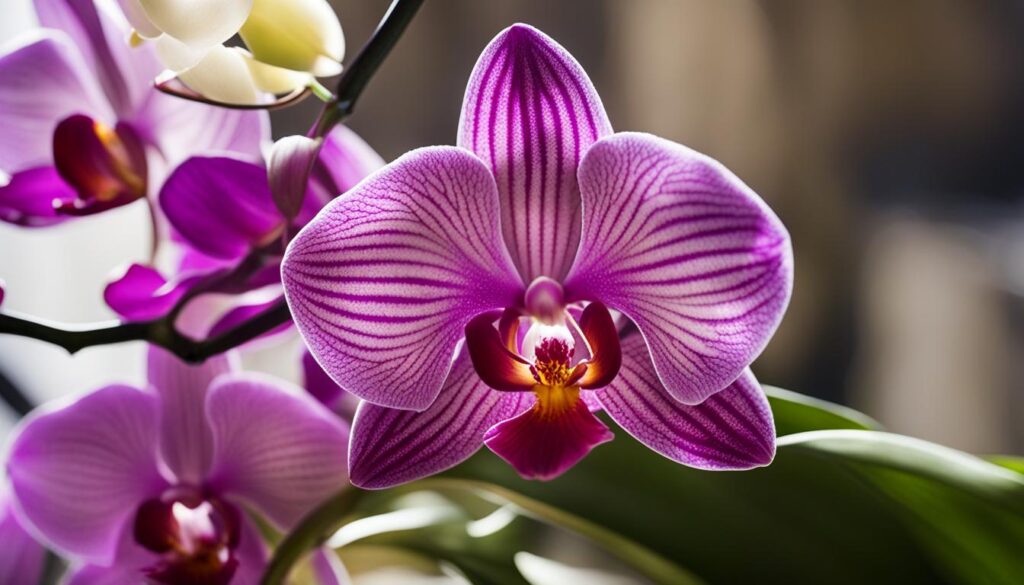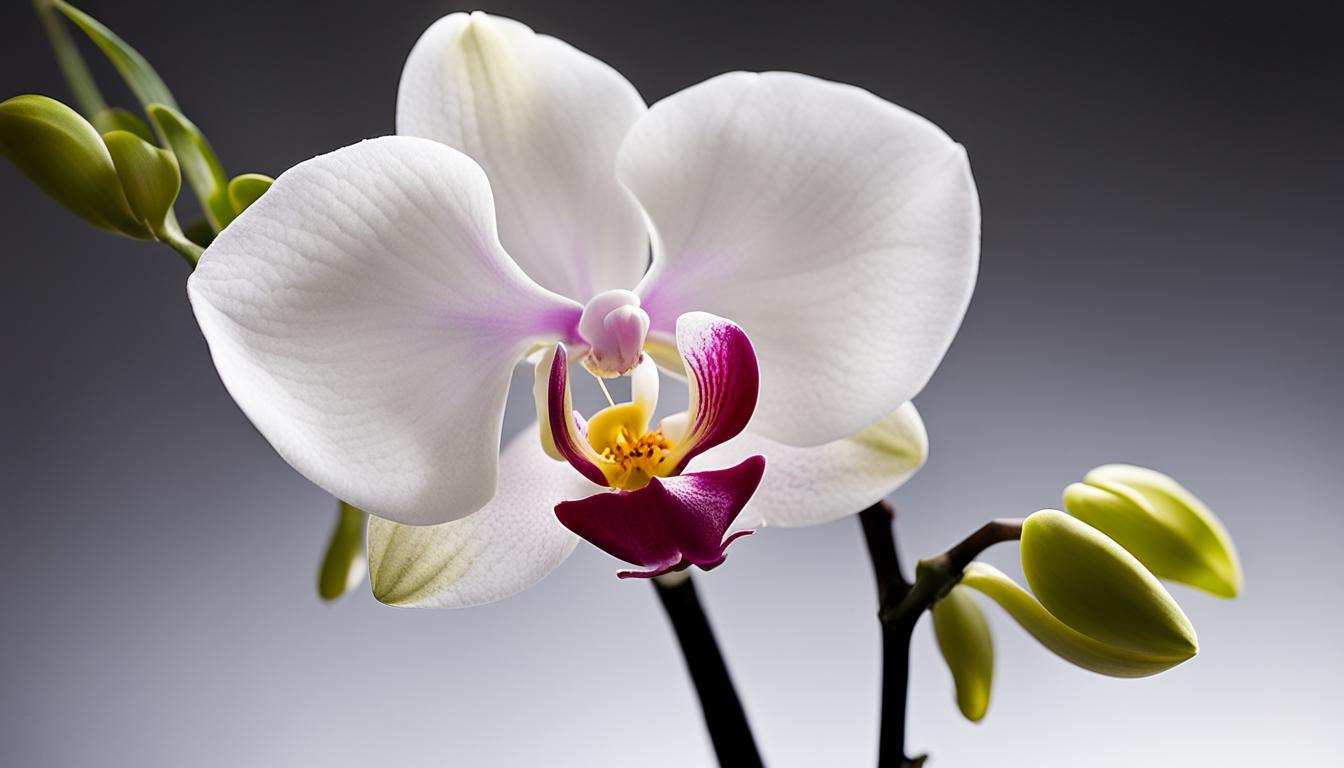As someone with a passion for cultivating orchids, I’ve learned that understanding orchid lighting requirements is the cornerstone of growing healthy orchids.
Just as professional athletes need the right kind of training and diet to perform, orchids need the right amount and type of light to blossom.
The quest for this understanding became pivotal in my previous home where natural light was a prized but scarce commodity.
Whether basking in sunlight or thriving under the glow of artificial lights, success in orchid care is heavily tied to light intensity, quality, and duration.
My journey taught me that a lack of sufficient light leaves orchids languishing without bloom, yet too much turn their elegant leaves into an unattractive canvas of sunburn.
Mastering the balance involved meticulous placement, sometimes armed with a light meter, and at other times, guided by the simplest hand shadow method, a Dance of Light, if you may, that determined the vibrancy and vitality of my orchidal charges. It’s an art as much as it is a science.
Key Takeaways
- Light is crucial for orchid photosynthesis and blooming; finding the right balance is key for their vitality.
- Both natural and artificial lights can foster orchid health, including options like LED and fluorescent.
- Intensity, quality, and duration of light must be managed to prevent issues like sunburn or inadequate blooming.
- Using tools such as light meters can aid in achieving the ideal light conditions for various orchid species.
- Placement by windows and also the use of artificial lighting should be strategic, considering the orchid’s genus-specific needs.
- Observation of foliage color and plant vigor are practical indicators of whether the light conditions are meeting an orchid’s requirements.
Understanding Orchid Light Intensity Necessities
As an avid orchid enthusiast, I can’t overstate the importance of light in the cultivation of these stunning plants. Orchids are not just elegant but are also excellent indicators of their own growing conditions.
To ensure a thriving orchid with vibrant blooms, getting the light, temperature and placement just right is crucial.
Let’s delve into how the intensity, temperature, and placement of light can make or break the health of your orchid.
Assessing Natural Sunlight Conditions for Orchids
I’ve found that to mimic an orchid’s natural habitat, assessing the quality of natural sunlight it receives is fundamental.
Orchids flourish in light conditions that range from the dappled shade of a forest canopy to the bright, indirect light of a tropical morning.
A prime location is key, and typically, an east or south-facing window affords the light most species crave.
However, every home is different, and so a good understanding of the suitable orchid light temperature for your specific species is essential.
Selecting the Best Orchid Light Source
Should your living conditions offer less-than-ideal lighting, fear not! The market offers a variety of artificial lights to suit your orchids’ needs.
From LED panels to specialized grow lights, the trick is in selecting the one that best replicates the necessary orchid light intensity and spectrum.
In my experience, a combination of natural light supplemented by artificial sources can ensure balanced growth for orchids, particularly in those darker months.
Importance of Proper Light Intensity for Orchid Health
Not all orchids are created equal when it comes to light needs. That’s why the necessary orchid light intensity will vary among genera such as Brassia, Cattleya, Dendrobium, and Phalaenopsis.
But, how do you gauge this elusive intensity? I frequently turn to light meters to measure intensity, ensuring my plants aren’t bathing in excess sunlight nor pining away in the shade.
Proper orchid light placement is a careful balance, contributing significantly to the overall health and aesthetics of the plant.
| Orchid Genus | Light Intensity (Footcandles) | Window Orientation | Artificial Light Alternative |
|---|---|---|---|
| Brassia | 1500-2500 | East/South-facing | Fluorescent Grow Lights |
| Cattleya | 2000-3000 | South-facing | LED Full-Spectrum |
| Dendrobium | 1500-2500 | East-facing | Combination LEDs |
| Phalaenopsis | 1000-1500 | East/North-facing | LED Panels |
In my journey, understanding these elements has transformed my home into a sanctuary for orchids, with each plant receiving the attention it needs regarding orchid growing conditions. Now, let’s visualize where these illustrious plants will thrive in your space.
Orchid Lighting Requirements: Harnessing the Power of the Sun
As an orchid enthusiast, I’ve realized that understanding the optimal orchid lighting duration is akin to mastering the art of solar appreciation. Depending on their geographical location, my orchids experience diverse photoperiods, long, sun-drenched days near the equator, and more variable durations as we move towards the poles.
To mimic these conditions indoors, especially during the dark winters, I utilize timed artificial lighting to ensure my plants receive a balanced day and night cycle.
It’s not just the duration that matters, but also the ideal orchid light spectrum, which encompasses all the colors crucial for plant health and growth.

For those who rely solely on natural light, positioning orchids where they can soak up the morning rays often works best.
However, when supplementing with artificial lights, I personally recommend a blend of full-spectrum fluorescents or LEDs. These sources not only provide consistency in light duration but also include the red, far-red, green, and blue wavelengths vital for robust growth.
Below is a table that illustrates the relationship between light spectrum and orchid health, helping you understand just how these varying wavelengths influence your orchid’s well-being.
| Light Spectrum | Plant Response | Orchid Benefit |
|---|---|---|
| Blue Wavelengths | Stimulate leaf growth | Dense foliage, sturdy stems |
| Red Wavelengths | Encourage flowering | Lush blooms |
| Far-Red Wavelengths | Affects growth patterns | Balanced plant architecture |
| Green Wavelengths | Fuels photosynthesis | Energy production for overall health |
As I continue to refine my home orchid garden, it’s evident that determining the optimal orchid lighting duration and ensuring exposure to the ideal orchid light spectrum are both non-negotiable pillars of cultivating thriving orchids.
With each passing season, my appreciation for these beacons of vitality grows, along with my orchids.
The Role of Light Duration in Orchid Care
When cultivating orchids indoors, one critical aspect to consider is managing the light duration to align with the plants’ natural requirements.
Under natural conditions, orchids are accustomed to specific day-length patterns that vary from season to season, which need to be replicated as closely as possible to promote healthy growth and flowering.
Mimicking Natural Daylight Hours with Artificial Lights
For orchid enthusiasts, artificial lighting presents an effective solution to providing consistent light duration throughout the year.
I’ve found that both LED and fluorescent light for orchids can simulate the natural light conditions orchids crave, with some careful planning and consideration of the recommended orchid light hours.
During the longer days of summer, it is commonly advised that orchids receive between 14-16 hours of light, while in the shorter daylight conditions of winter, 12-14 hours is often sufficient.
The offsetting of natural daylight variability through the use of artificial lighting ensures that orchids are not left groping in the dark during critical growth phases.

Using Timers to Regulate Ideal Orchid Light Spectrum
Utilizing timers with your lighting setup can vastly streamline the care process for your orchids by automating the switch between light and dark periods.
This not only ensures your orchids are enveloped in the light for the exact amount of time required, but it also frees you from the burden of remembering to manually adjust the lights daily.
Orchids like Cattleya labiata, whose blooming is triggered by the shortening day lengths of fall, are particularly sensitive to such precise light duration adjustments, emphasizing the importance of a reliable timer in your artificial light setup.
Understanding and managing the ideal light spectrum and duration is not just about ensuring your orchids survive; it’s about helping them thrive with vibrant blooms and robust health.
The balance struck between lead and fluorescent light for orchids and the natural rhythms they evoke can make all the difference in successful indoor orchid cultivation.
Choosing Artificial Light for Optimal Orchid Growth
As I’ve cultivated my passion for orchids, I’ve come to realize the undeniable importance of selecting the right type of artificial light to compensate for the lack of natural sunlight in certain environments.
Not all light sources are created equal, and different orchid species have varied requirements for successful growth.
Here’s how I discern between LED and fluorescent lighting for orchids and the significance of light temperature in their care.
Comparing LED and Fluorescent Lighting for Orchids
In my experience, when seeking the best orchid light source, two contenders frequently come to mind: LED and fluorescent lighting.
Both have their merits, with fluorescent light known for its cool temperature, which is highly beneficial for orchids like the Phalaenopsis.
However, LED lights, particularly full-spectrum varieties designed for indoor plants, have risen in popularity due to their energy efficiency and ability to cover all the necessary wavelengths orchids need for photosynthesis.

Here’s a table comparing the main features of both LED and fluorescent lighting to help illustrate their differences and similarities:
| Features | LED Lighting | Fluorescent Lighting |
|---|---|---|
| Spectrum | Full-spectrum, customizable | Broad-spectrum |
| Energy Efficiency | High | Moderate |
| Heat Emission | Low | Moderate |
| Initial Cost | Higher | Lower |
| Lifespan | Long (up to 50,000 hours) | Shorter (up to 20,000 hours) |
| Application | Suitable for all orchid types; optimal for high-intensity needs | Preferred for cool-temperature loving orchids like Phalaenopsis |
Understanding Color Spectrum and Light Temperature for Orchids
One must not overlook the light temperature when searching for an artificial lighting solution. Light temperature is a measure that reflects the color of the light emitted, which in turn can influence orchid growth and flowering.
While cooler light temperatures are generally better for vegetative growth, warmer temperatures may encourage flowering in certain orchid species.
The light from LEDs can mimic natural sunlight by providing a full spectrum of color temperatures, making them suitable for a variety of orchid types.
Conversely, fluorescent lighting typically has a cooler color temperature, which makes it excellent for promoting lush, green growth in the foliage of shade-loving orchids.
Ultimately, the right lighting choice depends on the specific needs of your orchid collection. Whether I choose LED or fluorescent fixtures, I make sure the light temperature aligns with the growth stage and species of orchid I am tending to, ensuring my blooms are as vibrant and healthy as they can be under artificial light.
Conclusion
As our journey through understanding the delicate dance of light and orchid health concludes, it’s clear that mastering orchid light intensity, precise orchid light placement, and optimal orchid light duration are cornerstones for nurturing these enchanting plants.
I’ve witnessed firsthand how the right lighting can foster an orchid’s growth and significantly enhance its potential to produce vibrant blooms.
It’s not merely about providing a light source, it’s about delivering the quality and quantity of light that echoes an orchid’s natural habitat, whether through the sun’s rays or artificial light for orchids like LED and fluorescent options.
I cannot stress enough the importance of understanding the specific light requirements your orchid species craves. This information becomes particularly impactful in scenarios where sunlight is scarce, and artificial lighting solutions are a necessity.
By utilizing tools to gauge and regulate light conditions or even introducing timers for those artificial sources, I’ve managed to create a thriving indoor orchid sanctuary.
Remember, achieving the right balance of light intensity, spectrum, and duration isn’t a luxury, it’s a requirement for any blossoming orchid collection.
Ultimately, I’ve learned through trial and success that the secret to a flourishing orchid display lies in the diligent observation and adjustments made in pursuit of replicating that perfect natural environment.
Whether you’re bathing your orchids in sunlight or bathing them in the glow of LED and fluorescent lights, paying close attention to your orchid’s response is key.
They’ll tell you what they need, and with the right care and adjustments, you’ll be rewarded with a stunning array of healthy blooms. I hope that this comes to fruition for orchid enthusiasts everywhere.
FAQ
What are the basic orchid lighting requirements for healthy growth?
Orchids require adequate light intensity, a suitable light spectrum, and proper light duration. They thrive under natural sunlight but can also grow well under artificial light if conditions replicate natural light as closely as possible. Using the correct placement and light source is key to fulfilling these requirements and promoting healthy orchid growth.
How do I assess natural sunlight conditions for my orchids?
Assessing the natural sunlight conditions involves observing the light’s intensity and duration throughout the day. East or south-facing windows are often ideal for providing the necessary light intensity without direct sun exposure that could cause burning. You can also use a light meter to measure the exact intensity or use simple hand shadow tests to estimate it.
What is the best orchid light source when natural light is not sufficient?
The best orchid light source is full-spectrum artificial lights such as LEDs or fluorescent lights. These provide a broad range of light wavelengths that mimic natural sunlight, promoting healthy growth and flowering. They are especially useful in the absence of sufficient natural light or during winter months with shorter daylight hours.
Why is proper light intensity important for orchid health?
Proper light intensity is crucial for the photosynthesis process, which provides the energy that orchids need for growth and flowering. Too little light can lead to weak, leggy plants, while too much light can cause leaf sunburn and damage. Each orchid genus has specific light intensity needs that should be met for optimal health.
What is the optimal orchid lighting duration during the day?
The optimal lighting duration, or photoperiod, generally mimics natural daylight hours. Orchids generally benefit from 12-14 hours of light daily during the winter months and 14-16 hours during the summer months. Adjustments may be necessary based on specific orchid species and changing seasons.
Should I use timers to regulate light for my orchids?
Yes, using timers to regulate your artificial lighting systems can provide a consistent photoperiod, ensuring your orchids receive the right amount of light each day. This is especially helpful in maintaining a stable growing environment and can assist with triggering flowering cycles in certain orchid species.
What should I look for when comparing LED and fluorescent lighting for orchids?
When comparing LED and fluorescent lighting for orchids, consider factors such as light spectrum, intensity, energy consumption, and heat output. LEDs are energy-efficient and emit little heat, making them a great choice for most orchids, while fluorescent lights provide a cooler temperature which can be preferable for certain species.
How does light temperature and color spectrum affect orchid growth?
Light temperature and color spectrum play significant roles in orchid growth and blooming. Orchids utilize different wavelengths of light for various growth processes. Blue light promotes vegetative growth, while red light is associated with flowering. A balance of these along with full-spectrum light sources ensure orchids get the diverse wavelengths they need for robust growth.


Leave a Reply